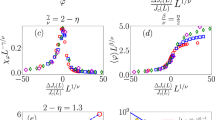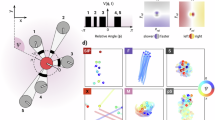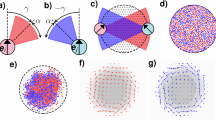Abstract
How do flocks, herds and swarms move through disordered environments? The answer to this question is crucial not only to animal groups in the wild, but also to effectively all applications of collective robotics and active materials composed of synthetic motile units1,2,3,4,5,6,7,8,9,10,11,12,13,14. In stark contrast, aside from rare exceptions15,16,17, our physical understanding of flocking has so far been limited to homogeneous media18,19,20. Here we explain how collective motion survives in geometrical disorder. To do so, we combine experiments and analytical theory to examine motile colloids cruising between randomly positioned microfabricated obstacles. We elucidate how disorder and bending elasticity compete to channel the flow of polar flocks along sparse river networks akin those found beyond plastic depinning in driven condensed matter21. Further increasing the disorder, we demonstrate that collective motion is suppressed in the form of a first-order phase transition generic to all polar active materials.
This is a preview of subscription content, access via your institution
Access options
Subscribe to this journal
Receive 12 print issues and online access
$259.00 per year
only $21.58 per issue
Buy this article
- Purchase on SpringerLink
- Instant access to full article PDF
Prices may be subject to local taxes which are calculated during checkout




Similar content being viewed by others
References
Kernbach, S. Handbook of Collective Robotics - Fundamentals and Challenges (Pan Stanford Edition, 2013).
Werfel, J., Petersen, K. & Nagpal, R. Designing collective behavior in a termite-inspired robot construction team. Science 343, 754–758 (2014).
Berman, S., Radhika, N. & Halasz, A. Optimization of stochastic strategies for spatially inhomogeneous robot swarms: a case study in commercial pollination. Proceedings of IEEE/RSJ International Conference on IntelligentRobots and Systems (IROS’11) 3923–3930 (IEEE Computer Society Press, 2011).
Shklarsh, A., Ariel, G., Schneidman, E. & Ben-Jacob, E. Smart swarms of bacteria-inspired agents with performance adaptable interactions. PLoS Comput. Biol. 7, e1002177 (2011).
Schaller, V., Weber, C., Semmrich, C., Frey, E. & Bausch, A. Polar patterns of driven filaments. Nature 467, 73–77 (2010).
Deseigne, J., Dauchot, O. & Chaté, H. Collective motion of vibrated polar disks. Phys. Rev. Lett. 105, 098001 (2010).
Thutupalli, S., Seemann, R. & Herminghaus, S. Swarming behavior of simple model squirmers. New J. Phys. 13, 073021 (2011).
Sanchez, T., Chen, D. T. N., DeCamp, S., Heymann, M. & Dogic, Z. Spontaneous motion in hierarchically assembled active matter. Nature 491, 431–435 (2012).
Theurkauff, I., Cottin-Bizonne, C., Palacci, J., Ybert, C. & Bocquet, L. Dynamic clustering in active colloidal suspensions with chemical signaling. Phys. Rev. Lett. 108, 268303 (2012).
Bricard, A., Caussin, J.-B., Desreumaux, N., Dauchot, O. & Bartolo, D. Emergence of macroscopic directed motion in populations of motile colloids. Nature 503, 95–98 (2013).
Palacci, J., Sacanna, S., Steinberg, A. P., Pine, D. J. & Chaikin, P. M. Living crystals of light-activated colloidal surfers. Science 339, 936–940 (2013).
Buttinoni, I. et al. Dynamical clustering and phase separation in suspensions of self-propelled colloidal particles. Phys. Rev. Lett. 23, 238301 (2013).
Lushi, E., Wioland, H. & Goldstein, R. E. Fluid flows created by swimming bacteria drive self-organization in confined suspensions. Proc. Natl Acad. Sci. USA 111, 9733–9738 (2014).
Nishiguchi, D. & Sano, M. Mesoscopic turbulence and local order in Janus particles self-propelling under an ac electric field. Phys. Rev. E 92, 052309 (2015).
Chepizhko, O., Altmann, E. G. & Peruani, F. Optimal noise maximizes collective motion in heterogeneous media. Phys. Rev. Lett. 110, 238101 (2013).
Reichhardt, C. & Olson Reichhardt, C. J. Active matter transport and jamming on disordered landscapes. Phys. Rev. E 90, 012701 (2014).
Quint, D. A. & Gopinathan, A. Topologically induced swarming phase transition on a 2D percolated lattice. Phys. Biol. 12, 046008 (2015).
Marchetti, M. C. et al. Hydrodynamics of soft active matter. Rev. Mod. Phys. 85, 1143–1189 (2013).
Vicsek, T. & Zafeiris, A. Collective motion. Phys. Rep. 517, 71–140 (2012).
Cavagna, A. & Giardina, I. Bird flocks as condensed matter. Annu. Rev. Condens. Matter Phys. 5, 183–207 (2014).
Reichhardt, C. & Olson, C. J. Depinning and nonequilibrium dynamic phases of particle assemblies driven over random and ordered substrates: a review. Preprint at http://arxiv.org/abs/1602.03798v1 (2016).
Bricard, A. et al. Emergent vortices in populations of colloidal rollers. Nat. Commun. 6, 7470 (2015).
Quincke, G. Über Rotationen im constanten electrischen Felde. Ann. Phys. 295, 417–486 (1896).
Jensen, H. J., Brass, A. & Berlinsky, A. J. Lattice deformations and plastic flow through bottlenecks in a two-dimensional model for flux pinning in type-II superconductors. Phys. Rev. Lett. 60, 1676–1679 (1988).
Grønbech-Jensen, N., Bishop, A. R. & Domínguez, D. Metastable filamentary vortex flow in thin film superconductors. Phys. Rev. Lett. 76, 2985–2988 (1996).
Troyanovski, A. M., Aarts, J. & Kes, P. H. Collective and plastic vortex motion in superconductors at high flux densities. Nature 399, 665–668 (1999).
Le Doussal, P. & Giamarchi, T. Moving glass theory of driven lattices with disorder. Phys. Rev. B 57, 11356–11403 (1998).
Faleski, M. C., Marchetti, M. C. & Middleton, A. A. Vortex dynamics and defects in simulated flux flow. Phys. Rev. B 54, 12427–12436 (1996).
Topinka, M. A. et al. Coherent branched flow in a two-dimensional electron gas. Nature 410, 183–186 (2001).
Pertsinidis, A. & Ling, X. S. Statics and dynamics of 2D colloidal crystals in a random pinning potential. Phys. Rev. Lett. 100, 028303 (2008).
Yan, L., Barizien, A. & Wyart, M. A model for the erosion onset of a granular bed sheared by a viscous fluid. Phys. Rev. E 93, 012903 (2015).
Chepizhko, O. & Peruani, F. Diffusion, subdiffusion, and trapping of active particles in heterogeneous media. Phys. Rev. Lett. 111, 160604 (2013).
Solon, A. P., Chaté, H. & Tailleur, J. From phase to microphase separation in flocking models: the essential role of nonequilibrium fluctuations. Phys. Rev. Lett. 114, 068101 (2015).
Vicsek, T., Czirók, A., Ben-Jacob, E., Cohen, I. & Shochet, O. Novel type of phase transition in a system of self-driven particles. Phys. Rev. Lett. 75, 1226–1229 (1995).
Grégoire, G. & Chaté, H. Onset of collective and cohesive motion. Phys. Rev. Lett. 92, 025702 (2013).
Kellerer, A. M. On the number of clumps resulting from the overlap of randomly placed figures in a plane. J. Appl. Probab. 20, 126–135 (1983).
Crocker, J. C. & Grier, G. Methods of digital video microscopy for colloidal studies. J. Colloid Interface Sci. 179, 298–310 (1996).
Acknowledgements
We acknowledge support from ANR program MiTra and Institut Universitaire de France. We thank F. Peruani, S. Santucci, M. C. Marchetti and D. Carpentier for valuable comments and suggestions. We also thank G. Fabre for help with the experiments.
Author information
Authors and Affiliations
Contributions
D.B. conceived the project. N.D., A.M. and D.B. designed the experiments. N.D. and A.M. performed the experiments. J.-B.C. and D.B. performed the theory. N.D., A.M., J.-B.C. and D.B. analysed and discussed results. D.B. and A.M. wrote the paper. N.D. and A.M. have equal contributions.
Corresponding author
Ethics declarations
Competing interests
The authors declare no competing financial interests.
Supplementary information
Supplementary information
Supplementary information (PDF 1650 kb)
Supplementary Movie 1
Supplementary Movie (MP4 20902 kb)
Supplementary Movie 2
Supplementary Movie (MP4 23891 kb)
Supplementary Movie 3
Supplementary Movie (MP4 20070 kb)
Supplementary Movie 4
Supplementary Movie (MP4 16992 kb)
Supplementary Movie 5
Supplementary Movie (MP4 16112 kb)
Rights and permissions
About this article
Cite this article
Morin, A., Desreumaux, N., Caussin, JB. et al. Distortion and destruction of colloidal flocks in disordered environments. Nature Phys 13, 63–67 (2017). https://doi.org/10.1038/nphys3903
Received:
Accepted:
Published:
Issue date:
DOI: https://doi.org/10.1038/nphys3903
This article is cited by
-
Swarming intelligence in self-propelled micromotors and nanomotors
Nature Reviews Materials (2025)
-
Patchy energy landscapes promote stability of small groups of active particles
Communications Physics (2024)
-
Active hydraulics laws from frustration principles
Nature Physics (2024)
-
Emergence of synchronised rotations in dense active matter with disorder
Communications Physics (2023)
-
Transient pattern formation in an active matter contact poisoning model
Communications Physics (2023)



